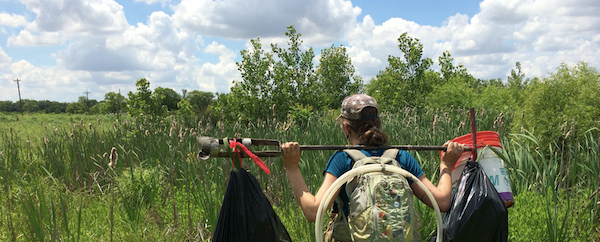MSES Candidate Melanie Rudolf traverses wetlands in her exploration of cattail species
Master of Science in Environmental Studies (MSES) candidate Melanie Rudolf has always seen the environment as more than just the sum of intricate parts.
"I started out as just biology when I came in as a freshman, but I wanted to get a broader environmental education," Rudolf said. "I wanted to take more plant biology courses, and I wanted to bring in human geography, as well."
Rudolf decided to make her own major, a Bachelor of Specialized Studies in "Environmental Biology and Sustainability." This uniquely OHIO education opportunity provided Rudolf with a broader brushstroke of environmental studies knowledge from multiple disciplines, biology being the uniting factor among her courses.
"I really went into biology because I enjoy being outdoors, and I'm interested in learning about everything that's outside," Rudolf said of her environmental studies interests. "As a kid, I wanted to know what every plant was, and what every bird that I saw was."
In her last semester prior to undergraduate graduation, Rudolf traveled to the Balkans region on the OHIO Environmental Peacebuilding & Sustainability studies study abroad program in the summer of 2015. At the time, the Peace Parks study abroad program was led by MSES program director Geoff Dabelko, who encouraged Rudolf on the trip to apply for an MSES assistantship after her graduation in December.
Upon acceptance into the Voinovich School's Environmental Studies master's program in spring 2016, Rudolf began her hourly, two-summer graduate assistantship position working with the Stream and Wetlands Foundation in May 2016.
Her first summer's fieldwork included traversing through regional wetlands with Robert Wiley, formerly the Voinovich School's ecology-environmental specialist.
"I had research experience in terrestrial biology, but I didn't have any prior knowledge about wetlands," Rudolf said. "We spent the entire summer walking around in marshes and swamps, getting muddy and trying to up my understanding of wetlands so that I could formulate a thesis question."
Her original wetlands exploration led her to questions about the function of the cattail in the overarching stream ecosystem – much like how her initial classes in biology led her to ask environmental ecosystem and sustainability questions at the undergraduate level.
"But it's really hard to tell what the function of a wetland is, and how this one plant species is affecting the function," Rudolf admitted.
Now Rudolf is applying an 'ecosystems approach' to cattail management strategies for her master's thesis, comparing the ecology in marshes dominated by the native, broadleaf cattail (Typha latifolia) to marshes dominated by a mixture of native, non-native (Typha angustifolia) and hybrid cattail (Typha x glauca).
These hybrid, invasive cattails often dominate the ecosystem landscape, shading out other plant species beneath its canopy cover and thereby reducing plant species diversity in the lower levels of the wetland ecosystem. Reduced macroinvertebrate biomass and enriched soil sediments are two other common features found with this invasive species present.
"It's difficult to tell if the cattail itself is changing the environment, like an ecosystem engineer, or if it's that the environment was already impacted and the cattails are thriving in that impacted environment," Rudolf said.
In an effort to slow the spread of the invasive cattail, wetland groups like the Stream and Wetlands Foundationemploy various management techniques. One of these commonly deployed techniques is spraying the native cattail with herbicides in an effort to stop the spread of the hybrid variety. In addition to spraying, wetland specialists also resort to cutting-and-flooding invasive cattail shoots to try and prevent further spread of the species.
In her research, Rudolf started asking about the validity of these cattail management strategies across different wetland-cattail scenarios. Previous studies have isolated pre-invasion and post-invasion cattail communities but they didn't compare it to an already existing cattail marsh, or a cattail-dominated community, according to Rudolf.
Rudolf thinks there's good reason for the gap in the cattail-community literature. "It's difficult to compare ecosystems because every ecosystem is different," she said. "The topography, the climate, the hydrology – it's all different."
Rudolf's research involves looking at ecosystem structures and processes, which included surveying plant species communities, aquatic macroinvertebrates, sediment nutrient cycling, and biomass calculations. She's even conducted studies of the leaf litter, to measure decomposition rates.
Her preliminary results show that current mitigation techniques for invasive cattail species in her selected field sites may not, in fact, be contributing to increases in ecosystem biodiversity as expected.
"From doing fieldwork I found that some of my wetland sites are slightly more diverse than others, but I haven't seen trends in native versus non-native wetlands," Rudolf said. "I've seen diverse non-native wetlands, and diverse native ones – and not-as-diverse native wetlands, as well. It's not black-or-white."
Rudolf, recently honored with an Original Work Grant for her thesis research, hopes her graduate degree will take her on to even more rewarding environmental work in the future.
"I really just want to find fulfillment in my work, and work with other people to protect the environment," Rudolf said.
As Rudolf concludes her research in her final semester at the Voinovich School, she hopes her findings help "inform wetland managers and wetland mitigation banks about managing cattail species – that maybe these strategies in-use are not the most beneficial way to manage these invasive species," Rudolf said.
Overall, Rudolf's notes that her experience at the Voinovich School has been a really incredible interdisciplinary and application-based graduate program.
"I felt like this master's program was really valuable because it brought together so many different backgrounds," Rudolf said. "I've gained a lot of knowledge that I don't think I would have learned had I just pursued a biology master's program."
The Voinovich School is currently seeking a master's candidate to fill the two-year Stream and Wetlands Foundation graduate assistantship. To learn more about the applicationand position requirements, contact Jen Bowman, director of environmental programs, at bowmanj2@ohio.edu.
